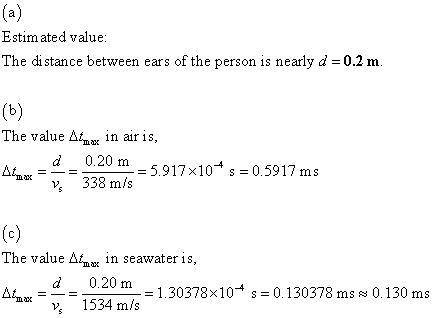
When you hear a noise, you usually know the direction from which it came even if you cannot see the source. This ability is partly because you have hearing in two ears. Imagine a noise from a source that is directly to your right. The sound reaches your right ear before it reaches your left ear. Your brain interprets this extra travel time (Δt) to your left ear and identifies the source as being directly to your right. In this simple model, the extra travel time is maximal for a source located directly to your right or left (Δt = Δtmax). A source directly behind or in front of you has equal travel time to each ear, so Δt = 0. Sources at other locations have intermediate extra travel times (0 ≤ Δt ≤ Δtmax). Assume a source is directly to your right.(a) Estimate the distance between a person's ears. (they gave us the answer of .2... apparently the program is messed up and we have to use .2(b) If the speed of sound in air at room temperature is vs = 338 m/s, find Δtmax. (Use your estimate.)
(c) Find Δtmax if instead you and the source are in seawater at the same temperature, where vs = 1534 m/s. (Use your estimate.)

Answers: 2
Other questions on the subject: Physics

Physics, 22.06.2019 05:30, gunnatvinson
What tightening torque should be used for a hexagonal head screw (not split-bolt) on a 250 kcmil conductor?
Answers: 3

Physics, 22.06.2019 07:10, cschellfamily
Road users moving into your lane, brake lights, and abrupt changes in road surface are a. rare at night b. indicators of potential hazards c. not worth worrying about before you reach them d. no problem for experienced drivers
Answers: 1

Physics, 22.06.2019 08:40, tasniahussain21
The system is released from rest with the cable taut, and the homogeneous cylinder does not slip on the rough incline. determine the angular acceleration of the cylinder and the minimum coeffi cient s of friction for which the cylinder will not slip.
Answers: 2

Physics, 22.06.2019 11:00, vanvalenpeyt
The star betelgeuse is about 600 light-years away. if it explodes tonight, a. we'll know because debris from the explosion will rain down on us from space. b. we'll know it immediately because it will be brighter than the full moon in the sky. c. we won't know about it until 600 years from now. d. none of the above.
Answers: 3
Do you know the correct answer?
When you hear a noise, you usually know the direction from which it came even if you cannot see the...
Questions in other subjects:






History, 15.11.2019 21:31



Mathematics, 15.11.2019 21:31







